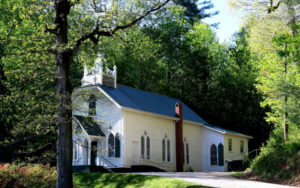DIRT IS MOVING at the new Southlawn project in downtown Lawrenceville. This shot is taken from the southern edge of the project with the First Baptist Church in the center of the photo, while at center left is the Historic Gwinnett Courthouse. How many readers can remember the exact location of the former Edge’s Cafeteria which was located on part of this property? (From Roving Photographer Frank Sharp.)
TODAY’S FOCUS: Alvin York Got Military Training at Norcross Range of Camp Gordon
EEB PERSPECTIVE: The Indians Used Weirs to Pull Fish from the Chattahoochee
ANOTHER VIEW: Animal Shelters Run by Counties Need More Regulation by the State
SPOTLIGHT: Georgia Gwinnett College
FEEDBACK: Not Voted Yet? Upcoming Debate Might Help You Decide on Governor
UPCOMING: Extra $500,000 Primerica Gift Helps Fund Homeless in Gwinnett
NOTABLE: Inaugural Show at Eagle Theatre in Sugar Hill Is Oscar Wilde Comedy
RECOMMENDED: The Landmark History of the American History by David Boorstin
GEORGIA TIDBIT: Soybean Growing Provides Unique Problems for Georgia Farmers
MYSTERY PHOTO: Watch Out Making Rash Guesses at Today’s Mystery Photo
CALENDAR: Suwanee Car Show at Town Center This Saturday
[button size=”small”]TODAY’S FOCUS[/button]
York got military training at Norcross Range of Camp Gordon
By Gene Ramsay
NORCROSS, Ga. | Alvin C. York was born in rural Tennessee in 1887, and during his first 30 years of life never ventured more than 50 miles from his birthplace. But in 1917 he was drafted into the United States Army to serve in World War I. After training at Camp Gordon in Chamblee, and at its associated rifle range near Norcross, his division was sent to France. There he served with great distinction in the ferocious battles in the fall of 1918, winning the Medal of Honor, our country’s highest award for valor.
Entering the Army, York was assigned to the 82nd Division, which was created at newly-established Camp Gordon in the summer of 1917. He wrote about his unit’s diverse background:
“The 82nd Division was known as the All-Amerkan (sp) Division. We wore the insignia A A on our shoulder. We were made up of boys from ‘most every state in the Union. . There were some mountaineers … there were Jews from the East Side of New York … English and Irish boys … and there were even some German boys. One-fifth of our men were of foreign birth, and several hundred were not even citizens of the United States. A right-smart number of them couldn’t speak or understand the American language. And a whole heap couldn’t read or write or even sign their own name.”
Camp Gordon (where DeKalb-Peachtree Airport is today) did not have an area suitable for use as a rifle range. As a result the army leased land for this purpose seven miles away, on the eastern edge of Norcross. The area was well-suited for the purpose: it had a long gentle slope leading to a creek, with a big hill on the opposite bank. The soldiers could practice rifle fire at distances of 100, 200 and 300 yards, and the hill was positioned to absorb stray bullets.
Alvin York was already an excellent shot when he entered the Army, having hunted game in Tennessee for many years to put food on his family’s table. But he found that many of his fellow soldiers in the 82nd did not have his level of experience, recalling that:
“… some of the boys … hadn’t been used to handling guns. Some of them didn’t even know how to load them, and when they fired they not only missed the targets, they missed the backgrounds on which the targets were fixed. They missed everything but the sky.”
These American soldiers of many backgrounds worked together to become a cohesive and effective combat unit. The division, sent to France in the spring of 1918, carried out the hard-fought Meuse-Argonne offensive in the fall of 1918.
In the midst of this mass of soldiers, York showed individual bravery. On October 9, 1918 he and a small squad of soldiers got behind enemy lines, and York used his skills as a marksman to take out at least nine of the opposing soldiers in a machine gun emplacement that was preventing the American advance. At that point, over 100 Germans surrendered to the much smaller American force. York’s courage enabled the entire American line to move forward.
Together the Allied forces overcame the experienced German Army that fall, leading to the armistice agreement signed a century ago, on November 11, 1918, ending the war.
After his army service York, having seen more of the world and the possibilities for the future, returned to his native Tennessee and became an active advocate for better education. He passed away in 1964.
- Have a comment? Send to: elliott@brack.net
The Indians used weirs to pull fish from the Chattahoochee
By Elliott Brack
Editor and publisher
OCT. 31, 2018 | Gwinnett’s western border, all the way from Lake Lanier to below Holcomb Bridge Road where Gwinnett meets DeKalb County, is the Chattahoochee River. That cold-water flowing river has been a major force for people in this area for years.
 When the Indians inhabited this area, the river was essentially a border between the Creek and Cherokee nations. As such it was something of a barrier, being difficult to cross. At low points, such as at what is today Jones Bridge, the river is shallow and rocky, allowing people to ford it, jumping from rock to rock.
When the Indians inhabited this area, the river was essentially a border between the Creek and Cherokee nations. As such it was something of a barrier, being difficult to cross. At low points, such as at what is today Jones Bridge, the river is shallow and rocky, allowing people to ford it, jumping from rock to rock.
With the arrival of the white man came ferries to cross the river, and later, bridges. Today the river is still a barrier, but one with several bridges, with motorists giving it little thought as they drive across.
Particularly in earlier days, the river was a source of food, especially protein, from its plentiful fish. The Indians somewhat tamed the river, building fish weirs, or watery traps, to make gathering fish from the river easier. One source says that fish weirs were maintained well into the 1700s.
Mary Hester of Duluth, who is CEO of LAN Systems of Berkeley Lake, a high-tech computer services company, got interested in these fish weirs, and documented them on her Homeowners Association website. Throughout the state of Georgia, it’s documented that there were at least 128 fishing weirs.
You can check out one primitive weir for yourself. One such weir Mary located is between State Bridge and Medlock Bridge Road, alongside the golf links of the Atlanta Country Club. You can see the remnants of the weir, as the water flows in a downward “V”, outlining the area.
These weirs were built by the Indians, and are quite an engineering feat. Most started with large rocks making stone dams under the water level, carefully constructed so as to channel the fish into this V. Limbs and poles were laid across the top of the weir. It was a rather simple and economical way to catch fish!
Some maintain that it was the Indian women who tended the weir. You can imagine women in the river, herding the fish by stirring up the water and driving the fish together. Then they could collect them in primitive baskets. No doubt they worked with pleasure at this. After all, they recognized that the fish would provide for their table, not only for the immediate meals, but by smoking the fish, they could continue to eat the river’s bounty during the winter months. Essentially, the river could help keep them alive.
Years later, with the Indians gone from the area, the settlers would continue to enjoy the fruits of the river. There is some indication that Indians even leased weirs to early settlers.
Weirs are no longer a focus of fishing from the Chattahoochee. Today the river remains popular as a trout stream. The cold waters help the trout thrive, with the Chattahoochee in this area the most southern of trout streams in Georgia.
By the way, if you want to fish the Chattahoochee, be alert: special regulations apply. Only artificial lures are allowed in the stretch from Georgia Highway 20 to Highway 141 (Medlock Bridge Road). If you use other bait, you could be in trouble.
Enjoy your fishing. Thanks, Mary, for this insight.
- Have a comment? Send to: elliott@brack.net
Animal shelters run by counties need more regulation by the state
By Jack Bernard, contributing columnist
PEACHTREE CITY, Ga. | It’s raining cats and dogs…and it’s bloody!
“Pet guardians are fooling themselves if they think the animal they turn in to a shelter is likely to find a new home. (In the Atlanta area) fully two-thirds of pets impounded in area shelters are killed.”-Georgia SPOT.
 Some people like to use the term euthanasia for terminating the life of an unwanted former pet. I don’t. I call it what it is: killing an abandoned or lost pet.
Some people like to use the term euthanasia for terminating the life of an unwanted former pet. I don’t. I call it what it is: killing an abandoned or lost pet.
Some counties are “no kill,” with adoptions as their focus. This is humane, and very costly for counties with limited budgets. Therefore, most Georgia counties have a policy that after a certain period of time, animals will be killed and cremated.
Unfortunately, most likely by design, no state agency keeps up with the number of pets killed in Georgia each year, although I think they should. Instead, because the public outrage would be significant if the numbers were compiled and released statewide, each county supposedly keeps this data.
Based on my experience as a county commissioner in a rural Georgia county near Atlanta, the accuracy of these numbers is questionable. At least one head of our Animal Control Center just told us what we wanted to hear, not the facts.
But, County Commissioners are also at fault. Centers are often understaffed. Three of our five commissioners refused to adequately staff our center. All said they were animal lovers but that the county could not afford the expense and “volunteers” should help out. So, the animals were left on their own a significant part of the time.
Theoretically, the Georgia Department of Agriculture (GDOA) regulates these shelters. But, rather than keeping up with the number of cats and dogs killed, the department has a listing of slots in centers by county. Simple to compile and administer, and purposefully meaningless.
So, what should be done about this deplorable situation? For starters, our governor should appoint a committee made up of prominent citizens, including politicians on both sides of the aisle, to recommend specific ways to reduce the deplorable killing of our dogs and cats.
Possible remedies would include:
- State funding for animal shelters;
- Greater regulation by GDOA in general;
- Mandated reports to GDOA regarding the number of animals in each shelter and the number put down annually;
- Identifying shelter best practices, including mandates such as shelters must be manned at all times; and
- State laws regarding neutering/spaying.
These remedies would regulate the field, and improve the overall situation.
- Have a comment? Send to: elliott@brack.net
Georgia Gwinnett College
 The public spiritedness of our sponsors allows us to bring GwinnettForum.com to readers at no cost. Georgia Gwinnett College (GGC) is a four-year, accredited liberal arts college that provides access to associate and baccalaureate level degrees that meet the economic development needs of the growing and diverse population of Gwinnett County and the northeast Atlanta metropolitan region. Georgia Gwinnett produces future leaders for Georgia and the nation. Its graduates are inspired to contribute to their local, state, national and international communities and are prepared to understand and to engage in an ever-changing global environment. GGC currently serves nearly 13,000 students pursuing degrees in 17 majors and more than 45+ concentrations. Visit Georgia Gwinnett College¹s web site at www.ggc.edu.
The public spiritedness of our sponsors allows us to bring GwinnettForum.com to readers at no cost. Georgia Gwinnett College (GGC) is a four-year, accredited liberal arts college that provides access to associate and baccalaureate level degrees that meet the economic development needs of the growing and diverse population of Gwinnett County and the northeast Atlanta metropolitan region. Georgia Gwinnett produces future leaders for Georgia and the nation. Its graduates are inspired to contribute to their local, state, national and international communities and are prepared to understand and to engage in an ever-changing global environment. GGC currently serves nearly 13,000 students pursuing degrees in 17 majors and more than 45+ concentrations. Visit Georgia Gwinnett College¹s web site at www.ggc.edu.
- For a list of other sponsors of this forum, click here.
Not voted yet? Upcoming debate might help you decide on governor
Editor, the Forum:
![]() Which gubernatorial candidate—Stacey Abrams or Brian Kemp—is best for Georgia? It is likely that there are thousands of independent, moderate and mainstream Georgia voters like me who are puzzling to answer this question before casting ballots on November 6.
Which gubernatorial candidate—Stacey Abrams or Brian Kemp—is best for Georgia? It is likely that there are thousands of independent, moderate and mainstream Georgia voters like me who are puzzling to answer this question before casting ballots on November 6.
To help provide some clarity, please replay the Tuesday, October 23 Georgia gubernatorial debate on Georgia Public Broadcasting www.gpb.org or C-SPAN www.c-span.org and tune in to the debate on WSB-TV Channel 2 this Sunday, November 4 at 5 p.m.
— Jeff Ploussard, Lilburn
Send us your thoughts: We encourage you to send us your letters and thoughts on issues raised in GwinnettForum. Please limit comments to 300 words. We reserve the right to edit for clarity and length. Send feedback and letters to: elliott@brack.net
Extra $500,000 Primerica gift helps fund homeless in Gwinnett
What would it be like to not know where you would lay your head at night, or where your next meal was coming from? What would it be like to live in your car, parking behind Wal Mart and praying you and your children would be safe for the night?
It’s hard to imagine these things but sadly, thousands of people in Gwinnett County and Metro Atlanta find themselves in these very situations every day – homeless, hungry and in despair.

The Board of Trustees for The Primerica Foundation includes, from left, Randy Redner, Kelly Patterson, Anne Soutter, Karen Fine Saltiel, Margaret Halbert and William Nemetz.
Primerica, the Duluth-based financial services company, is working through their corporate foundation to help their fellow citizens in need in Gwinnett and Metro Atlanta through the Neighbors in Need funding. This funding was made possible by an extra gift of $500,000 from the Foundation’s corporate benefactor, Primerica.
The Primerica Foundation has also joined forces with Gwinnett County and the United Way of Greater Atlanta to address the critical issues of homelessness and hunger by establishing the HomeFirst Gwinnett (HFG) initiative. The Primerica Foundation has donated a total of $149,000 to HomeFirst Gwinnett.
The HFG initiative is led by Matt Elder. United Way is the fiscal agent for HGF until it establishes its own 501 (c)(3) designation. The goals of HFG are to develop a strategic plan that identifies long-term solutions to homelessness and the development of a Coordinated Entry System to navigate and connect people in need with resources in Gwinnett County.
In addition to supporting HFG, Neighbors in Need funding from The Primerica Foundation was granted to several other nonprofits in Gwinnett County and Metro Atlanta including: City of Refuge in Atlanta, Family Promise of Gwinnett, G.R.I.P. in Gwinnett County, Gateway Center in Atlanta, Habitat for Humanity in Gwinnett County, Gwinnett County Food Pantry Project, Nothing But the Truth, Rainbow Village The Salvation Army( Home Sweet Home Program) and Vets Resource Center in Gwinnett County.
Karen Fine Saltiel, chair of The Primerica Foundation, says: “At Primerica we believe that when our community is successful, we are successful. Giving back is a mission very close to our hearts. Saltiel will be retiring from Primerica at the end of this year. “It has been my greatest joy to be part of the Gwinnett community,” she says.
Snellville releases names of streets to be paved next year
Snellville’s annual paving contract has been approved . The low bidder is a local company, E.R. Snell Contractor, with a low bid of $698,448.85.
 The streets which will be paved before June 1, given good weather, are:
The streets which will be paved before June 1, given good weather, are:
- Summit Place Drive
- Summit Place Way
- Summit Edge Circle
- Summit Edge Court
- Summit Tree Terrace
- Summit Springs Circle
- Summit Springs Court
- Summit Glen Drive
- Summit Glen Circle
- Summit Pond Road
City Manager Butch Sanders praised E.R. Snell for being the lowest bidder and a strong supporter of the city. “We all owe a word of thanks to (E.R. Snell),” he said.
New Kudzu Art exhibition entitled “Lasting Impressions”
 Escape the current chaos by checking out a new exhibit at Kudzu Art Zone in Norcross. Called “Lasting Impressions”, it is a show by member artists, hinting at what has made an impression on them. Whether an abstract suggesting a fleeting past image, their love of flowers or nature, places visited that have stayed with them, or faces that haunt their memories, this exhibit has something for everyone.
Escape the current chaos by checking out a new exhibit at Kudzu Art Zone in Norcross. Called “Lasting Impressions”, it is a show by member artists, hinting at what has made an impression on them. Whether an abstract suggesting a fleeting past image, their love of flowers or nature, places visited that have stayed with them, or faces that haunt their memories, this exhibit has something for everyone.
Kudzu Art Zone and Galleries are open Tuesdays through Saturdays from 11 a.m. to 4 p.m. and are located at 116 Carlyle Street in downtown Norcross. In addition to current exhibits, Kudzu is home to eight artists’ working studios, classes and workshops with a goal of providing art and culture opportunities for the community. For more information call 770-840-9844 or see the website: www.kudzuartzone.org.
Inaugural show at Eagle Theatre in Sugar Hill Is Oscar Wilde comedy
The City of Sugar Hill and the Players Guild of Sugar Hill present The Importance of Being Earnest as the inaugural show in the city’s new Eagle Theatre. The show runs from November 2-18. The Eagle Theater is located at 5029 West Broad Street. Parking is available along the street and in the brand new 100-space underground parking deck under the newly developed E Center.
The 406-seat, Art Deco style performing arts theatre is home to the Players Guild at Sugar Hill and the Broad Street Concert Band. The City of Sugar Hill is focused on the vision of a creating a community space where residents and guests can gather and enjoy the arts.
The Players Guild at Sugar Hill has been performing together since 2014 with Chairman Ane Mulligan and Vice Chairman Alan Hyma at the helm. The non-profit organization is rapidly growing and with the opening of the Eagle, their popularity will continue to grow exponentially.
The guild’s performance of The Importance of Being Earnest is being directed by Jimmy Spearman. It is the most renowned of Oscar Wilde’s comedies. For more information or tickets, visit eagleatsugarhill.com.
Gwinnett Tech scores again with service to veteran students
 Gwinnett Technical College has once again been recognized as one of the best in the nation for its outstanding Veterans Services by Military Times.
Gwinnett Technical College has once again been recognized as one of the best in the nation for its outstanding Veterans Services by Military Times.
Their Best: Colleges 2019 rankings, formerly known as Best for Vets, has Gwinnett Tech ranked third among career and technical colleges in the nation for its commitment to education and providing opportunities to America’s veterans, service members and their families. This marks the third consecutive year Gwinnett Tech has moved up in the rankings and the second consecutive year in the Top 5. In 2018, the College was ranked 4th in the nation.
The Landmark History of the American History by David Boorstin
![]() rom Frank Sharp, Lawrenceville: Dr. Daniel Boorstin, a Georgian and former Librarian of Congress Emeritus, wrote a classic two-volume history of the American History. It is a masterpiece of exposition, drama and storytelling. Here’s just one short excerpt: “During their first winter of 1620-21 the Puritans would have died without some reliable advice about how to survive in America. Sequanto was an Indian kidnapped by an English sea captain who sold him into slavery in Spain. He escaped to England and learned English and returned to New England in 1619. In March, 1621, Sequanto out of the thousands of Indians knew enough English to act as the interpreter. He showed the Pilgrims how to plant corn (not known in England), how to fertilize the soil, where to catch fish, and how to trap for beaver. No wonder the Pilgrims called him a “special instrument sent by God for their good beyond their expectation.
rom Frank Sharp, Lawrenceville: Dr. Daniel Boorstin, a Georgian and former Librarian of Congress Emeritus, wrote a classic two-volume history of the American History. It is a masterpiece of exposition, drama and storytelling. Here’s just one short excerpt: “During their first winter of 1620-21 the Puritans would have died without some reliable advice about how to survive in America. Sequanto was an Indian kidnapped by an English sea captain who sold him into slavery in Spain. He escaped to England and learned English and returned to New England in 1619. In March, 1621, Sequanto out of the thousands of Indians knew enough English to act as the interpreter. He showed the Pilgrims how to plant corn (not known in England), how to fertilize the soil, where to catch fish, and how to trap for beaver. No wonder the Pilgrims called him a “special instrument sent by God for their good beyond their expectation.
An invitation: what books, restaurants, movies or web sites have you enjoyed recently? Send us your recent selection, along with a short paragraph (100 words) as to why you liked this, plus what you plan to visit or read next. Send to: elliott@brack.net
Soybean growing provides unique problems for Georgia
Soybeans, introduced to Georgia in the 18th century, are raised today in the state as a source of cooking oil and animal feed. Researchers at the University of Georgia (UGA) are also examining the crop’s potential for the production of biofuel and as a more palatable foodstuff.
Originating in China, the soybean is a major crop worldwide. The first soybean crop raised in America is thought to have been planted in Georgia by Samuel Bowen in 1765. After the East India Company ship, on which Bowen was employed, arrived in the American colonies from China, Bowen declined to return aboard and instead settled in Savannah, where he planted and harvested a soybean crop.
With encouragement from the U.S. Department of Agriculture, which was founded in 1862, farmers in the southern states began planting soybeans as forage for their livestock. In 1904 agricultural scientist George Washington Carver of Tuskegee University in Alabama discovered that soybeans were a valuable source of protein and oil. He also discovered that soybeans worked well as a cover crop, which is a crop planted to enrich the soil after the major crop is harvested.
Soybean production in the United States has increased continually since the19th century. Today, the nation’s farmers plant nearly 77 million acres of soybeans and rely on the crop for animal feed. Livestock in the United States consume about 25 million tons of soybean meal annually.
Soybean farmers in Georgia plant an average of 180,000 acres each year, significantly less than other crops. For example, farmers in the state devote 1.3 million acres to cotton and 755,000 acres to peanuts. In 2004 Georgia farmers produced 8.37 million bushels of soybeans, and the state soybean crop was valued at $47.5 million.
Soybeans present unique challenges for Georgia farmers. Traditional varieties, grown primarily in the Midwest, are very susceptible to drought in the sandy soils of Georgia’s coastal plain. According to soybean specialists, the potential for drought in Georgia makes soybeans less economically feasible than other crops. Also, Georgia farmers use their irrigated acres for such higher-value crops as cotton, peanuts, and vegetables because they are generally paid less for soybeans than are midwestern growers.
Georgia farmers who plant soybeans grow them primarily as an oilseed crop—the beans are harvested and crushed to produce oil for cooking. The meal produced by crushing the beans is used as animal feed and as a food ingredient. Soybean oil can also be used to produce biodiesel, a fuel made from such renewable materials as vegetable oils or animal fats. Scientists with the University of Georgia College of Agricultural and Environmental Sciences are conducting biodiesel feasibility studies and biotechnology research on several crops, including soybeans.
UGA researchers are also working with a new variety of soybean, L-Star, which could have greater appeal for Georgia farmers. Soybean flowering is dictated by night length, and unlike traditional varieties, L-Star would get the day and night lengths it requires in Georgia. Developed by the National Agricultural Research Organization in Japan, L-Star is touted for its “less beany” taste. The naturally deodorized soybean does not contain lipoxygenase, the enzyme linked to the unpopular flavor. Food scientists at UGA have also developed a soy milk and tofu with L-Star beans.
A major obstacle to L-Star’s success in Georgia is its fragility. In 2005 farmers faced problems at harvest time because the L-star pods shatter easily. When the beans dry, the pods open and the beans fall out before the farmer’s combine can harvest the crop. Researchers at UGA are working to help farmers address the harvesting problems.
- To view the Georgia Encyclopedia online, go to http://www.georgiaencyclopedia.org
Watch out making rash guesses at today’s Mystery Photo
This may not be what it seems for today’s Mystery Photo. So put on your search mode and see what you can find out. Send your answers to elliott@brack.net, including your hometown.
 Paul Thurner, formerly of Norcross and now of Sarasota, Fla., was the first to identify the most recent Mystery Photo.” I always enjoy the mystery photos, but almost never know them. Today I immediately recognized the University of Pittsburgh’s Cathedral of Learning. My sister’s daughter graduated from Pitt. I had visited her in Pittsburgh on a couple of different times. Interesting to read the history. Located on Fifth Avenue the Cathedral of Learning is one of the world’s tallest educational buildings, and was built in the late 1920s hence the Art Deco influences. It was built for education and still remains in that purpose.” The photo came from the camera of George Graf of Palmyra, Va.
Paul Thurner, formerly of Norcross and now of Sarasota, Fla., was the first to identify the most recent Mystery Photo.” I always enjoy the mystery photos, but almost never know them. Today I immediately recognized the University of Pittsburgh’s Cathedral of Learning. My sister’s daughter graduated from Pitt. I had visited her in Pittsburgh on a couple of different times. Interesting to read the history. Located on Fifth Avenue the Cathedral of Learning is one of the world’s tallest educational buildings, and was built in the late 1920s hence the Art Deco influences. It was built for education and still remains in that purpose.” The photo came from the camera of George Graf of Palmyra, Va.
Others recognizing it include Scott LeCraw, Suwanee; Lou Camerio, Lilburn; Susan McBrayer, Sugar Hill; and Robert Foreman, Grayson, who said: “My wife is from Pittsburgh. So this one looked somewhat familiar. It is the Cathedral of Learning at the University of Pittsburgh, Pittsburgh, Pennsylvania.” From Lilburn, Bobby Tkacik adds: “It is the Cathedral of Learning at the University of Pittsburgh. The office of the chancellor of Pitt is on the first floor of the Cathedral of Learning. My Grand Uncle was the Chancellor for a few months back in the early 1960s before a heart attack.”
![]() COMMUNITY FORUM of issues about women will be the focus of this event, to be held Thursday, November 1 at 6 p.m. at the Gwinnett Justice and Administration Center in Lawrenceville.The event is free. Online registration is required at https://rebrand.ly/herwalk.
COMMUNITY FORUM of issues about women will be the focus of this event, to be held Thursday, November 1 at 6 p.m. at the Gwinnett Justice and Administration Center in Lawrenceville.The event is free. Online registration is required at https://rebrand.ly/herwalk.
REMEMBERING WORLD WAR I: Thursday, November 8 from at 7 p.m., at OneStop Centerville., 3025 Bethany Church Road, Snellville. Look at period photos and uniforms, and learn from historian Gene Ramsey about how World War I affected Gwinnett County. This tribute is to the 30 Gwinnettians who died in The Great War, and is presented in partnership with the Gwinnett County Public Library, the Georgia WWI Centennial Commission, and the Gwinnett Historical Society.
CONCUSSION DISCUSSION will be Friday, November 9, from 11 a.m. until 3 p.m. at the Busbee Center of Gwinnett Technical College. This will be an educational symposium and awareness day put on by Gwinnett Medical Center’s Concussion Institute. Topics include concussion care best practices and protocols; challenges in concussion care; new programs unfolding in Georgia; and concussion management.
CAPELLA’S MARTIAL ART, or barbershop harmony, with the Stone Mountain Chorus, will have two performances on Saturday, November 10 at the Peachtree Corners Baptist Church, at 2 p.m. and 7 p.m. This year’s special guest artists are Banks and Shane, an Atlanta entertainment tradition since 1972. Tickets are online at the secure web site: www.stonemountainchorus.org. Advance purchase tickets are $22, with discounts to $20 for seniors (60+), students and groups (12+). All tickets at the door are $25, cash or personal check.
SUWANEE CLASSIC CAR SHOW will be Sunday, November 11, at Town Center Park from 10 a.m. until 5 p.m. This is sponsored by the North Gwinnett Arts Association. Showcasing a variety of cars, including street rods, muscle cars, trucks, exotics, and imports, the show will also feature Junior Dragsters on exhibit, Paint-A-Wreck, a silent auction, 50/50 raffle, music by Uptown Entertainment, and artists creating in the park. Prizes will be offered in several categories.
VETERAN’S DAY ceremony will be November 11 at 1:30 p.m. at the Fallen Heroes Memorial located at the Gwinnett Justice and Administration Center. With granite slabs bearing the names of the honored dead as a backdrop, the ceremony will include an honor guard, speakers, including Col. Rick White, co-director and chairman of the Georgia Military Veterans Hall of Fame. There will be a 21-gun salute, and bugler playing Taps. The Fallen Heroes Memorial is located at 75 Langley Drive, Lawrenceville.
GwinnettForum is provided to you at no charge every Tuesday and Friday.
Meet our team
- Editor and publisher: Elliott Brack, 770-840-1003
- Managing editor: Betsy Brack
- Roving photographer: Frank Sharp
- Contributing columnist: Jack Bernard
- Contributing columnist: Debra Houston
- Contributing columnist: George Wilson
More
- Location: We are located in Suite 225, 40 Technology Park, Peachtree Corners, Ga. 30092.
- Work with us: If you would like to serve as an underwriter, click here to learn more.
Subscriptions to GwinnettForum are free.
- Unsubscribe. We hope you’ll keep receiving the great news and information from GwinnettForum, but if you need to unsubscribe, go to this page and unsubscribe in the appropriate box.
© 2018, Gwinnett Forum.com. Gwinnett Forum is an online community commentary for exploring pragmatic and sensible social, political and economic approaches to improve life in Gwinnett County, Ga. USA.

















Follow Us